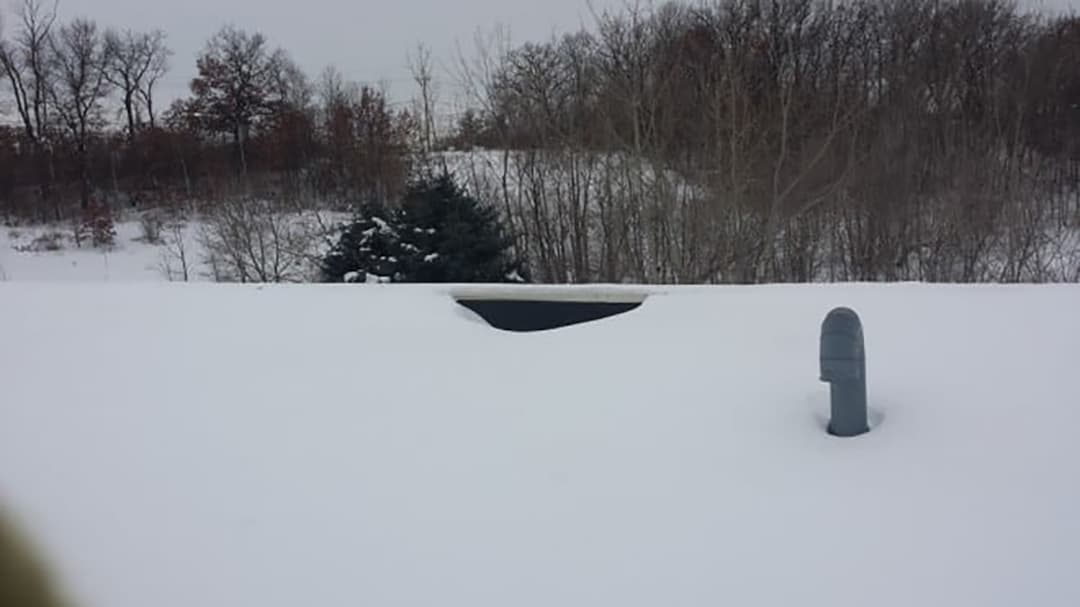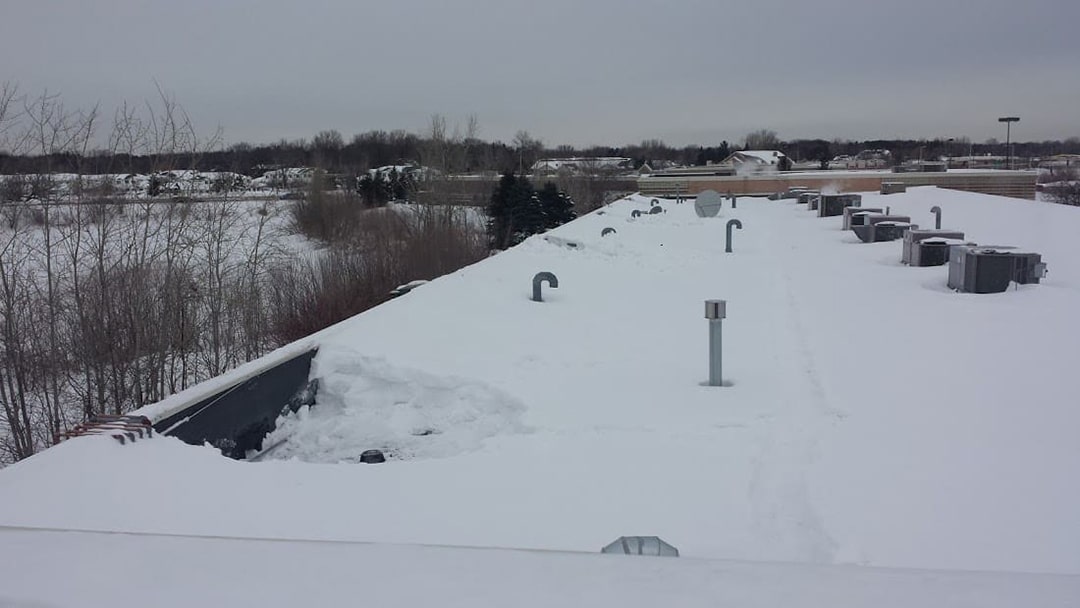Winter’s enchanting transformation brings not only a scenic blanket of snow but also the need for vigilant snow load safety. Commercial property owners must grapple with the challenge of understanding how their roofs can effectively handle the weight that accumulates during the colder months. Beyond the picturesque landscapes, the accumulated snow poses a silent threat, requiring a nuanced comprehension of snow load safety. In this article, we embark on a journey to decipher the factors influencing a roof’s capacity to handle the weight of snow, providing essential insights for fortifying your commercial property against the seasonal burden.
This article serves as your guide to navigating the challenges presented by snow load on commercial roofs. Together, we will unravel the complexities involved in safeguarding your investment against the silent force of accumulated snow. From deciphering the geographical nuances that dictate snowfall to understanding the critical role of roof design and adherence to building codes, we will explore the multifaceted aspects of snow load safety.
As winter descends, let’s embark on a journey to demystify snow load safety — a journey that will equip you with the insights and tools necessary to ensure your commercial roof stands strong against the seasonal pressures it faces.
What Factors Determine the Snow Load on a Roof?
Snow load on a roof is a critical consideration in ensuring the structural integrity of a building during winter. Several factors come into play when determining the snow load, each influencing the burden that a roof must bear. One primary factor is the density of the snow. Not all snow is created equal, and the weight it exerts on a roof depends on its moisture content. Light, fluffy snow carries less weight per cubic foot compared to wet, dense snow, making it crucial to assess the type of snowfall in a given region.
Ice is another significant factor in determining snow load. When snow accumulates and melts, then refreezes, it transforms into ice, significantly increasing its weight. This ice accumulation on a roof, known as ice dams, can exacerbate the overall snow load. The interplay between snow and ice adds complexity to the calculations involved in assessing a roof’s capacity to handle winter precipitation effectively.

Pressure, both static and dynamic, plays a pivotal role in snow load determination. Static pressure results from the weight of the snow itself, pressing down on the roof surface. Dynamic pressure, on the other hand, comes into play when wind causes drifting or redistribution of snow. These variations in pressure create uneven loading on different sections of the roof, emphasizing the importance of a comprehensive understanding of these factors to accurately assess and manage the snow load on a roof.
How Much Snow Can a Roof Safely Hold: Understanding the Key Factors

Weight is a critical consideration when assessing the structural capacity of commercial roofs, particularly for flat roofs. The load-bearing capacity of a flat roof comes under scrutiny when accommodating heavy equipment, such as a 300lb HVAC unit, which occupies a space of 2.5 x 2.5 feet. This weight distribution across the roof’s surface is a crucial factor in ensuring the safety and longevity of commercial roofs. Understanding the impact of static and dynamic forces, including snow load, is essential for maintaining structural integrity and ensuring the safety of the entire commercial property.
For commercial properties with flat roofs, the forces acting upon the roof include not only the static weight of equipment but also dynamic forces like wind and gravity. These forces can exacerbate stress on the roof, making it imperative to consider not only the weight of stationary elements like HVAC units but also the impact of external environmental factors. Regular assessments of the roof’s weight-bearing capacity, taking into account both static and dynamic forces, are essential components of effective property management practices. This comprehensive understanding is crucial for ensuring the safety of commercial roofs, especially in regions where snow load is a significant concern.
Flat roofs, by design, demand meticulous attention to their weight-bearing capacity to support additional loads from equipment or environmental forces. Incorporating safety measures and strategies for managing snow load becomes integral to the regular assessments and maintenance practices. This proactive approach not only ensures the longevity of commercial roofs but also safeguards the well-being of the entire commercial structure.
Assessing the Strength Above: A Step-by-Step Guide to Calculating Commercial Roof Load-Bearing Capacity
A safe and sound commercial roof is the backbone of any successful business. To ensure its stability and longevity, knowing its load-bearing capacity is paramount. This guide unravels the intricacies of calculating this crucial aspect, equipping you with the knowledge to confidently evaluate your roof’s strength.
Step 1: Unmasking the Load Factors:
Understanding the different forces impacting your roof is the first step. Dead loads, like the weight of the roofing materials and structure, are constant and easily identified. Live loads, however, are dynamic and include the weight of snow, occupants, equipment, and wind. Local building codes and design standards provide specific values for these loads based on your region and roof type.
Step 2: Mapping the Roof’s Surface:
Accurate measurements are the cornerstone of reliable calculations. Carefully measure each individual roof section, meticulously considering its dimensions and any unique features. By applying basic geometric formulas, you can determine the total surface area of each plane, providing the canvas for further calculations.
Step 3: Load Distribution: From Uniform to Concentrated:
Different loads exert their force in distinct ways. Dead loads, often uniformly distributed, can be readily multiplied by the total surface area to determine their impact. Live loads, however, require more nuanced calculations. Snow drifts, for example, must be accounted for using specific factors and distribution patterns. Wind loads also require consideration, with their complex effects necessitating specialized calculations.
By meticulously following these steps and utilizing accurate data, you can acquire a precise understanding of your commercial roof’s load-bearing capacity. This knowledge empowers you to make informed decisions about weight distribution, snow removal, and any necessary structural modifications, ensuring the enduring stability and safety of your business’s foundation.
Navigating Winter’s Burden: Proven Strategies to Mitigate Roof Load Risks
As winter descends, a quiet threat often lurks overhead: the potential for excessive snow accumulation on your roof. The weight of heavy snow can pose significant risks, causing structural damage, leaks, and even roof collapse. Fortunately, proactive measures can be taken to mitigate these risks and ensure your roof withstands the winter’s burden.
1. Know Your Roof’s Snow Load Capacity:
The foundation of winter roof preparedness lies in understanding your roof’s snow load capacity. This information, usually found in building plans or obtained from a structural engineer, specifies the maximum weight of snow your roof can safely bear. Knowing this limit allows you to monitor snow accumulation and take necessary actions before it exceeds safety thresholds.
2. Monitor Snow Accumulation and Take Action:
Proactive snow monitoring is crucial throughout winter. Regularly inspect your roof, especially after heavy snowfalls, to assess snow depth and distribution. Pay close attention to areas prone to drifting, which can lead to localized overloading. If snow depth approaches or surpasses your roof’s capacity, prompt action is necessary. Consider hiring professional snow removal services to ensure safe and efficient snow clearing.
3. Install Roof Heating Systems:
Roof heating systems offer a proactive solution for managing snow accumulation. These systems, typically utilizing electric cables or hydronic tubing embedded beneath the roof surface, can melt snow as it falls, preventing excessive weight buildup. This proactive approach can significantly reduce the risk of roof damage and provide peace of mind during winter months.
4. Implement Snow Guards:
Snow guards act as physical barriers, preventing large amounts of snow from avalanching off the roof at once. These strategically placed devices help control the rate and direction of snowmelt, minimizing the risk of overloading and potential damage to gutters, landscaping, and other surrounding elements.
5. Regular Roof Maintenance:
Maintaining your roof in optimal condition throughout the year is key to ensuring its ability to withstand winter’s challenges. Regular inspections by qualified professionals can identify and address potential issues like worn-out materials, cracks, or leaks before they worsen under the weight of snow. Addressing these concerns promptly can prevent significant damage and costly repairs in the long run.
By implementing these proven strategies, you can confidently navigate the winter season and safeguard your roof from the burden of heavy snow. Remember, proactive planning and preventative measures are essential for protecting your property and ensuring the safety of your loved ones.
In conclusion, safeguarding your commercial property against the seasonal challenges of snow load is not just a precautionary measure; it’s a proactive investment in the longevity and safety of your structure. As you navigate the intricacies of snow load safety, remember that you’re not alone in this journey.
Allweather Roof, a premier commercial roofing company in Minnesota, stands ready to assist. With a steadfast commitment to delivering top-notch commercial roofing solutions, Allweather Roof brings unparalleled expertise to the table, ensuring that your roof is not only well-equipped but also benefits from a level of service that exceeds expectations. Armed with this knowledge and the support of trusted professionals, you are empowered to make informed decisions, from assessing geographical influences to implementing effective mitigation strategies. As winter descends, let your partnership with Allweather Roof and the understanding of your commercial roof’s capabilities be the guiding force in fortifying your investment, ensuring resilience against the weight of snow, and fostering a secure environment for years to come.


